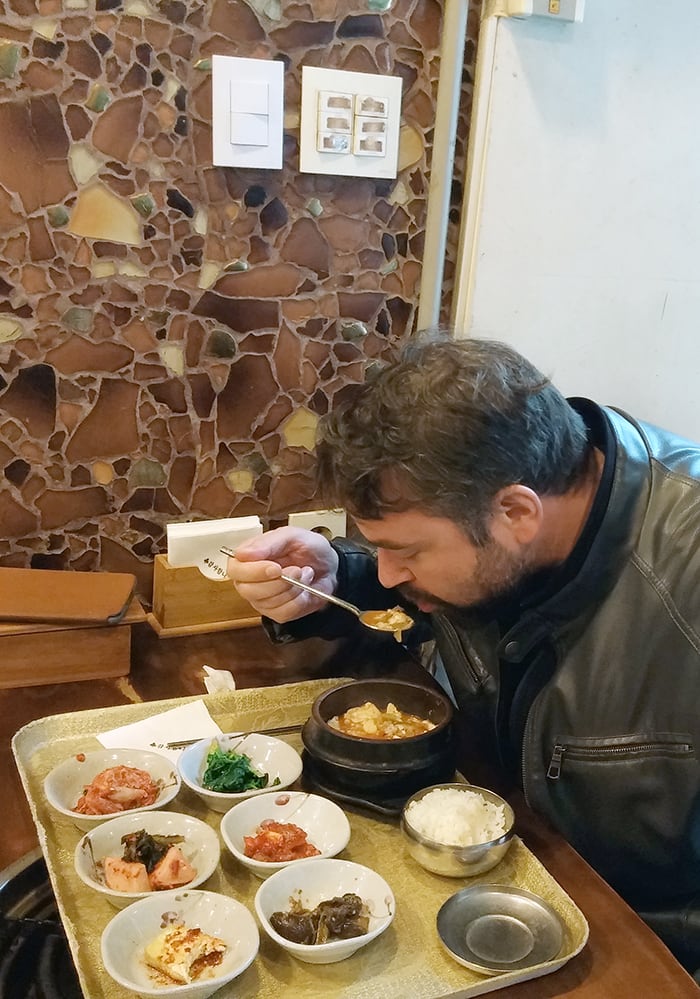The jagged rectangle of the Korean Peninsula juts southward out of Manchuria, at the far eastern edge of the Asian landmass. Being thusly located, Korea has always shared in East Asia’s extraordinary wealth of vegetables and plant life. It’s estimated that Western Europe has about 80 species of commercially useful, indigenous trees. North America has about 250. East Asia, in contrast, has some 500. This rich biological diversity has been critically important to Korean civilization, giving the peninsula an extremely adaptable natural environment that has given its inhabitants a great variety of resources. At the core of all this is the soybean, Glycine max.

Spicy soft tofu soup is a Korean staple that’s available most anywhere there’s a Korean restaurant.
According to East Asian myth, the god of medicine and agriculture Shennong, the divine farmer and the emperor of the five grains, declared that five plants were sacred: rice, wheat, barley, millet and, of course, soybeans. Korean archeological digs show that soybeans similar to modern soybeans have been cultivated on the peninsula at least since before 1,000 B.C.
Tofu, or soy bean curd, is simply coagulated soy milk that has been pressed into blocks. Scholars believe tofu-making techniques entered the peninsula in the 700s, during Silla times (57 B.C.-A.D. 935). There are thousands of ways to make tofu, depending on the region, dish and technique. One Korean method of tofu-making is to make a soft tofu that’s perfect for a spicy soup. This soon tofu is a type of tofu that’s made without hardening the curd in a frame. The curd is allowed to “free form”, so to speak, making it softer and less formed.
Fast forward to today, and a staple of modern Korean cooking is one of the myriad types of tofu soup. Spicy soft tofu soup, or soondubu jjigae (순두부 찌개), is probably the most common type. It’s available — literally — everywhere. Except for specialized restaurants and fast food joints, every run-of-the-mill Korean restaurant, in Korea and probably around the world, serves spicy soft tofu soup.
Note that the dish could probably also be translated as “kimchi tofu soup”, since it quite often includes kimchi in the recipe. However, not to confuse it with the more authentic “kimchi soup” (김치 찌개), we’re going to go with “spicy soft tofu soup” since the prime ingredient here is the soft tofu, not the fermented cabbage.

A meal of spicy soft tofu soup will rarely set you back more than KRW 7,000 or 8,000.
The three pillars of Korean cuisine are red pepper paste, soy sauce and soybean paste, and all three of them are involved in the preparation of spicy soft tofu soup. The dish can be made either spicy or not spicy, and can include a whole range of ingredients. Many people like it with slices of pork and kimchi. Some people put in small clams. Red pepper flakes and red pepper paste are always used in the broth. It’s normally served boiling hot in a traditional stone pot that doubles as a bowl. A raw egg can be added, which cooks in the boiling broth, for an additional kick of protein. The broth — as with all broths — is prepared using anchovies, kelp and slices of Asian radish. You can throw in shiitake mushrooms, enoki mushrooms, green onions, either red or green chili peppers, sesame oil, fish sauce and, of course, garlic. Seafood spicy soft tofu soup can include shrimp, clams and squid. The dish is basically a red spicy soup with soft tofu and anything else that’s in the refrigerator.

Spicy soft tofu soup is enjoyed by people from all walks of life.
So as you eat your way across Korea, I encourage you to not disregard the simpler, more common soups and stews. They’re healthy, delicious, affordable and give you a true taste of Korean cuisine.
By Gregory C. Eaves
Korea.net Staff Writer
Photos: Gregory C. Eaves
gceaves@korea.kr























